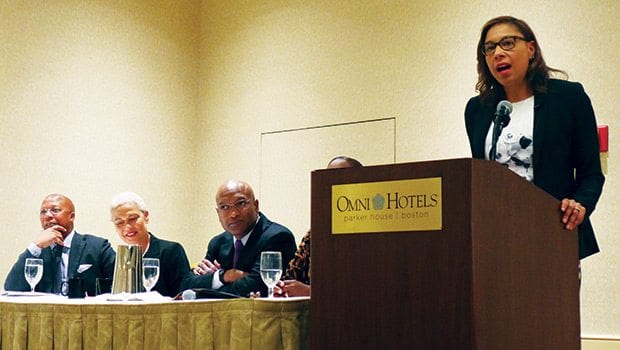
When the Federal Reserve Bank of Boston released a study earlier this month showing extremely low levels of wealth among the city’s black and Latino residents, it came as a sobering wake-up call. However, a report on black philanthropy in Boston released last week highlighted a different story about black-led philanthropic efforts to drive social change.
The report, released by New England Blacks in Philanthropy and conducted by Dr. Ange-Marie Hancock of the University of Southern California, examined the philanthropic giving habits of blacks in Boston and called for efforts to more effectively coordinate black giving in Boston for better impact.
The study was conducted over the course of 18 months and involved 300 participants in a mix of in-depth interviews, an online survey, and three focus groups. While previous research had highlighted the level of philanthropic giving among blacks, this study sought to provide a deeper dive into questions of where blacks are giving their money, how they make decisions about giving, and how their donorship could be better leveraged for greater impact.
“We were seeking to understand not only what our community thinks about philanthropy, but also how people engage,” said NEBIP president Bithiah Carter at the report’s launch last Thursday.
A diverse range of interests
The report answered those questions in part by tracing a pattern among survey constituents who explained their motivations for giving. It found respondents generally fell into one of three groups of givers — those who gave to organizations based on subject area (like the arts or cancer research); those who gave to organizations based on their service of the black community in particular; and those who gave primarily to their faith communities.
Significantly, the study found that black giving was not as tied to the church as many people assumed. While most respondents said they thought that church giving was the center of black philanthropy, almost half (48 percent) of survey respondents said they did not attend nor give to religious institutions regularly.
The study also found a wide range between the percent of disposable income that was donated to various types of causes: extended family members and friends (31 percent), religious institutions (25 percent), direct service, educational institutions and arts (between 16 and 18 percent each), and political campaigns and advocacy groups (13 percent each).
Missed opportunities
The finding that seemed to resonate most with audience members at the launch centered on organizations’ failure to fully tap into black donorship. The study found a gap between many donors’ desire to be more strategic in their giving and the way that organizations — black and mainstream alike — fail to capitalize on that desire due to lack of research and tracking of outcomes. For instance, one respondent reported giving a large donation to a university, only to receive a solicitation the next year asking for just $25 – a missed opportunity on the university’s part.
Chandra Anderson, who was at the report’s launch and is president and CEO of New York-based Anderson Consults, agreed.
“Consistently cultivating relationships with major donors is a major challenge for smaller non-profit organizations, particularly community-based organizations for people of color,” she said. “Organization leaders must be equipped with strong donor outreach skills and encouraged to spend more time cultivating donors.”
While one panelist, Ms. Benaree Wiley of The Wiley Group, said she felt the opposite — that she was being solicited too much — she noted that the issue might be that the same people are asked for donations over and over. Dr. Hancock said that was precisely the case.
“The circle of giving is not being expanded,” she said.
Next steps
Looking forward, the report identified several key needs within black philanthropic circles: (1) a kind of information clearinghouse of quality organizations in Boston that focus on the needs to black residents; (2) better education among organizations on the collective giving habits of black donors and more intentional relationship-building with donors. (3) more thorough information from charitable organizations about their effectiveness and real-world impact and (4) more educational resources — such as online videos and webinars — on financial literacy and charitable giving that could help people plan their donations in a more intentional and effective manner.
Bruce Bickerstaff, Chairman of the Roxbury Trust Fund, said he found the report to be a useful launch pad for change, stressing the importance of philanthropy to catalyze social and political change in Boston’s communities of color.
“We have to recognize our wealth to leverage it and get interest in our communities in a way that is reciprocal,” he said.
He used the example of a sneaker store being built in a community to illustrate the kind of development that does come to neighborhoods like Roxbury but that does not do much to transform the community.
“We have to articulate and demand some reciprocity,” he said. “Other ethnic groups have done it in their own ways.”
Both the report and comments at the launch event highlighted a popular desire to have some “tough conversations” on several hot-button topics, including the considerable ethnic diversity within black Boston and divisions along generational, class and education lines.
In response to these concerns, the report called for an effort to connect across such divisions to “transition from a diversity game of ‘just faces in the room’ to an equity game of ‘having the power to change policy and make decisions.’”






